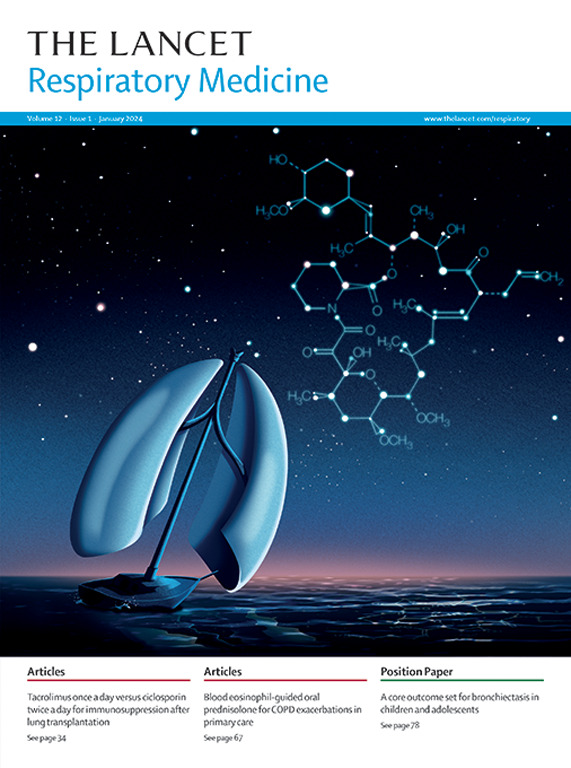Projecting the 30-year burden of obstructive sleep apnoea in the USA: a prospective modelling study
IF 32.8
1区 医学
Q1 CRITICAL CARE MEDICINE
引用次数: 0
Abstract
Background
Obstructive sleep apnoea is a common disorder that is associated with major public health and economic burden across the USA. Previous studies have assessed the prevalence of the condition. In the present study, we aimed to estimate the burden of obstructive sleep apnoea across the USA from 2020 to 2050, to guide public health policies and management pathways.Methods
In this prospective modelling study, historical data on obstructive sleep apnoea prevalence in the USA were extracted from a previously published longitudinal cohort study. US population characteristics (age and sex) were obtained from relevant and validated population data sources, and data on BMI were obtained from the National Health and Nutrition Examination Survey and the Wisconsin Sleep Cohort. To project the obstructive sleep apnoea burden (cases and prevalence) into 2050, we developed an open cohort dynamic population simulation model.Findings
On the basis of projected changes in US age, sex, and BMI population distributions, the model predicts a significant rise in obstructive sleep apnoea over the next three decades. By 2050, the prevalence of obstructive sleep apnoea (apnoea–hypopnoea index ≥5/h) is expected to show a relative increase of 34·7%, from 34·3% (95% uncertainty interval [UI] 34·0–34·4) to 46·2% (46·0–46·4), resulting in 76·6 million cases. We estimate that females will see a larger relative increase than males, with a 65·4% relative increase in prevalence, from 22·8% (22·5–23·0) to 37·7% (37·4–38·0) reaching a total of 30·4 million cases. Males are projected to show a more moderate relative increase of 19·3%, from 45·6% (45·4–46·0) to 54·4% (54·2–54·7), reaching 45·9 million cases.Interpretation
Projections indicate that obstructive sleep apnoea will affect 76·6 million adults aged 30–69 years across the USA in 2050, with a disproportionate growth among females compared with males. These findings highlight the urgent need for targeted public health strategies and revised access to diagnosis and follow-up pathways to address the growing prevalence of obstructive sleep apnoea, particularly among females.Funding
Resmed.预测美国30年的阻塞性睡眠呼吸暂停负担:一项前瞻性模型研究
背景:阻塞性睡眠呼吸暂停是一种常见的疾病,在美国与主要的公共卫生和经济负担有关。以前的研究已经评估了这种情况的患病率。在本研究中,我们旨在估计2020年至2050年美国阻塞性睡眠呼吸暂停的负担,以指导公共卫生政策和管理途径。方法在这项前瞻性建模研究中,从先前发表的纵向队列研究中提取了美国阻塞性睡眠呼吸暂停患病率的历史数据。美国人口特征(年龄和性别)从相关且经过验证的人口数据来源获得,BMI数据来自国家健康与营养检查调查和威斯康星睡眠队列。为了预测2050年阻塞性睡眠呼吸暂停负担(病例和患病率),我们开发了一个开放队列动态人口模拟模型。根据美国年龄、性别和BMI人口分布的预测变化,该模型预测在未来30年,阻塞性睡眠呼吸暂停症的发病率将显著上升。到2050年,阻塞性睡眠呼吸暂停(呼吸暂停-低通气指数≥5/h)的患病率预计将相对增加34.7%,从34.3%(95%不确定区间[UI] 34.0 ~ 34.4)增加到46.2%(46.0 ~ 46.4),达到7660万例。我们估计,女性将比男性出现更大的相对增长,患病率相对增长65.4%,从22.8%(22.5 - 23.0)增加到37.7%(37.4 - 38.0),总数达到3040万例。预计男性的相对增长较为温和,为19.3%,从45.6%(45.4 - 46.0)增加到54.4%(54.2 - 54.7),达到4590万例。预测表明,到2050年,美国将有7660万30-69岁的成年人受到阻塞性睡眠呼吸暂停的影响,其中女性的增长与男性相比不成比例。这些发现突出表明,迫切需要制定有针对性的公共卫生战略,修订诊断和随访途径,以解决阻塞性睡眠呼吸暂停症日益普遍的问题,特别是在女性中。
本文章由计算机程序翻译,如有差异,请以英文原文为准。
求助全文
约1分钟内获得全文
求助全文
来源期刊

Lancet Respiratory Medicine
RESPIRATORY SYSTEM-RESPIRATORY SYSTEM
CiteScore
87.10
自引率
0.70%
发文量
572
期刊介绍:
The Lancet Respiratory Medicine is a renowned journal specializing in respiratory medicine and critical care. Our publication features original research that aims to advocate for change or shed light on clinical practices in the field. Additionally, we provide informative reviews on various topics related to respiratory medicine and critical care, ensuring a comprehensive coverage of the subject.
The journal covers a wide range of topics including but not limited to asthma, acute respiratory distress syndrome (ARDS), chronic obstructive pulmonary disease (COPD), tobacco control, intensive care medicine, lung cancer, cystic fibrosis, pneumonia, sarcoidosis, sepsis, mesothelioma, sleep medicine, thoracic and reconstructive surgery, tuberculosis, palliative medicine, influenza, pulmonary hypertension, pulmonary vascular disease, and respiratory infections. By encompassing such a broad spectrum of subjects, we strive to address the diverse needs and interests of our readership.
 求助内容:
求助内容: 应助结果提醒方式:
应助结果提醒方式:


